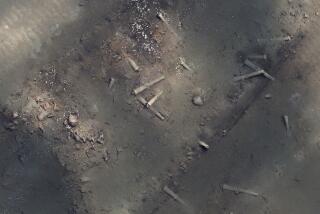HISTORY : 82 Years After Sinking, Titanic Still in Spotlight : Upcoming exhibit appalls some Britons, who see ‘grave robbery.’ But the museum cites artifacts’ importance.
- Share via
LONDON — The controversial loss of the Titanic has fascinated generations of Britons and Americans: The “unsinkable” luxury liner with its famous passengers sank on its maiden voyage in 1912 after ramming an iceberg in the Atlantic.
Controversial aspects of the sinking of the world’s largest ship, sailing from Southampton, England, to New York, have often been recounted; more than 1,500 lives were lost and the actions of senior officers were criticized. The ship had lifeboats for only half the 2,228 passengers and crew and did not reduce speed or alter its course despite repeated iceberg warnings.
Now Britain’s National Maritime Museum is preparing a major exhibition called “The Wreck of the Titanic,” and it has generated controversy too.
The exhibit, scheduled to open Oct. 4, will include a porthole, a chandelier, a champagne bottle with its contents intact, crystal, traveler’s checks, statuettes, bracelets, a shaving brush and a leather cigarette case--complete with cigarettes.
Relatives of the Titanic’s victims and others argue that the relics recovered by U.S. and French salvagers in 1987 and 1993 should have been left with the wreck and that it is ghoulish to hold an exhibition of them.
Don Smith, great-nephew of the Titanic’s captain, Edward J. Smith, who went down with the ship, said the exhibition of 150 items is “nothing short of grave robbery. The dead should be allowed to rest in peace.”
And the British Titanic Society says that the exhibition is “insensitive” and is “compounding an already emotive issue.”
“We object to the fact that it’s being used for commercial gain,” said Titanic Society Vice President Bob Pryor. “If they have to do this, they should gather the items into one place as a memorial to those who still lie buried in the wreckage.”
The Titanic was located, resting more than two miles deep, by a French-American expedition with deep-diving submersibles in 1985. Since then about 2,600 artifacts have been removed fromthe ship, which rests in at least two sections.
George Tulloch, the chairman of the salvage company, RMS Titanic Inc., said it agreed not to sell any of the relics and would keep them together for public view.
If company projections of the number of visitors who wish to see the relics are correct, RMS Titanic stands to make a large profit from the exhibition, which will tour the world for five years.
Columnist Bernard Levin of the Times of London joined the critics recently, asking, “How can we allow trinket hunters to plunder the watery grave of the Titanic and put their booty on show?”
But Adm. Lord Lewin, chairman of the museum trustees, countered, “The ethical aspects were considered very carefully . . . , and certain principles were established: that the artifacts should always be kept together as a collection and never sold, that the collection will always be available for public display and that the aim should be to establish a permanent museum that would be a Titanic memorial.”
Dr. Stephen Deuchar, the museum’s head of exhibitions, added, “The slice of life represented by Titanic’s passengers and crew, from every social class and more than 20 countries, renders the ship a unique time capsule with immense historical significance. The artifacts on display will also bring to life, in a unique way, Titanic’s brief but legendary history.”
Millvina Dean was 9 weeks old when her mother bundled her into a lifeboat, leaving her father behind on the Titanic. She says she has mixed feelings.
“I was against bringing the artifacts up in the first place,” she said. “I didn’t want anything to be touched, because I thought my father was there.
“But once they had brought them up from the seabed, there was nothing anyone could do about it, and I thought people might as well see the things as a part of history.”
The Maritime Museum is in Greenwich, on the River Thames.
More to Read
Sign up for The Wild
We’ll help you find the best places to hike, bike and run, as well as the perfect silent spots for meditation and yoga.
You may occasionally receive promotional content from the Los Angeles Times.






